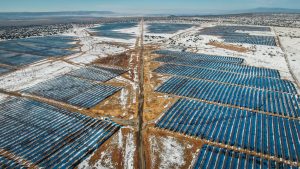 Solar energy is a growing contributor to renewable energy generation in the United States — the Energy Information Administration projects a 75% solar electricity generation increase between 2023 and 2025. The nation’s existing electrical infrastructure can accommodate solar projects, so independent investors, private groups, utility companies and government agencies will look to connect solar farms to the power grid. Learn about this process and how SelectROW can help.
Solar energy is a growing contributor to renewable energy generation in the United States — the Energy Information Administration projects a 75% solar electricity generation increase between 2023 and 2025. The nation’s existing electrical infrastructure can accommodate solar projects, so independent investors, private groups, utility companies and government agencies will look to connect solar farms to the power grid. Learn about this process and how SelectROW can help.
How Does a Solar Farm Connect to the Grid?
Solar farms connect to the existing power grid by establishing a point of interconnection (POI) to reach consumers. Two common interconnection methods are substation interconnection and line tapping:
- Substation interconnection: For this method, the solar farm sends electricity through a generation intertie (gen-tie) line to a new or existing substation. The substation offers essential distribution equipment, such as step-up transformers that increase the voltage to accommodate long-distance travel.
- Line tapping: Line tapping bypasses the substation, instead establishing the POI on a transmission line. A direct solar POI may require switchgear, inverters or batteries to either reduce voltage before entering smaller transmission lines or increase voltage before entering larger ones.
Commercial Vs. Residential Interconnection
Most solar farms are for commercial or residential use, and the end user influences the farm’s size, output capacity and point of interconnection.
A commercial solar farm is a utility-scale assembly that can generate 200 megawatts of electricity or more. Utility-scale solar farms produce electricity for a widespread customer base and, therefore, transmit electricity through the largest segments of the grid. Due to their output capacity, these farms commonly utilize substation interconnection.
Residential farms often generate community-scale electricity — smaller quantities for consumers near each other. Most utility-scale solar power generation caps at 5 megawatts per farm, especially in 19 states and Washington D.C., where legislation establishes a ceiling. The reduced output capacity enables community-scale solar farms to tap into local transmission lines. Larger utility-scale farms may need to install batteries or inverters at the POI.
The Importance of Solar Interconnection
As solar farms grow in prominence and scale, so does the need for deliberate interconnection design, installation and maintenance. Solar farm developers, government agencies, utility companies and other energy sector stakeholders collaborate for technically sound, cost-effective integration. Grid interconnection contributes to:
- Solar farm feasibility: Cost-effective solar farm operation reduces the risk of revenue loss from service disruptions, equipment damage and worker injuries.
- Energy exchange efficiency: Structured voltage regulation and flow control result in low-loss electricity transmission between the gen-tie and grid.
- Solar energy demand fulfillment: Large-scale solar energy procurement and distribution meet a portion of society’s electricity demand.
- Energy sector sustainability: Eco-conscious electricity procurement reduces the energy sector’s environmental footprint.
- Solar energy affordability: Market-viable utility costs make efficient solar electricity a competitive option for consumers.
- Energy sector workplace safety: Technically sound grid connection methods protect employees from injury and death when establishing and maintaining the POI.
- Regulatory compliance: Secure electrical grid integration follows National Electrical Code® (NEC) standards.
Business and Legal Steps for Interconnection
Grid interconnection involves various steps beyond the design, engineering and establishment of a gen-tie POI.
Construction, Installation and Operation Permission Obtainment
The solar farm owner must receive construction approval from the local Authority Having Jurisdiction (AHJ) that upholds codes in the area and permission to install from the utility owner that manages distribution to customers.
Depending on state and local laws, the AHJ may require schematics to display safety and engineering solutions that follow Underwriters Laboratories (UL) 1741 and Institute of Electrical and Electronics Engineers (IEEE) 1547 standards.
Upon approval from both entities, solar farm and gen-tie development may commence. The AHJ must review and approve the completed project.
After passing the AHJ inspection, the solar farm owner may request interconnection approval and permission to operate from the utility owner. The utility owner will install a bidirectional meter at any approved POI to measure electricity flow.
Land Acquisition
The development and maintenance of solar farms, gen-ties, substations and POIs often require organizations to access land belonging to a private owner or public agency. Obtaining the right to pass through or operate on that land during and after a solar project’s development is a critical step.
How Will SelectROW Help With Your Commercial Solar Project?
SelectROW will advance the process of pursuing a timely, feasible agreement with land owners. Our real estate, law and project management professionals have extensive experience in solar energy land acquisition issues and project management.
Our solar site and gen-tie capabilities have helped energy sector clients select land parcels, obtain easements and right-of-ways, and manage community relationships. We have direct experience leveraging our expertise and resources within transmission line projects that intersect with major landowners, strict regulations and passionate communities.
Contact SelectROW for Property and Easement Acquisitions
SelectROW accelerates project timelines and insulates investment returns by leveraging our extensive experience with the energy sector. We invite you to request a proposal to discuss your project.